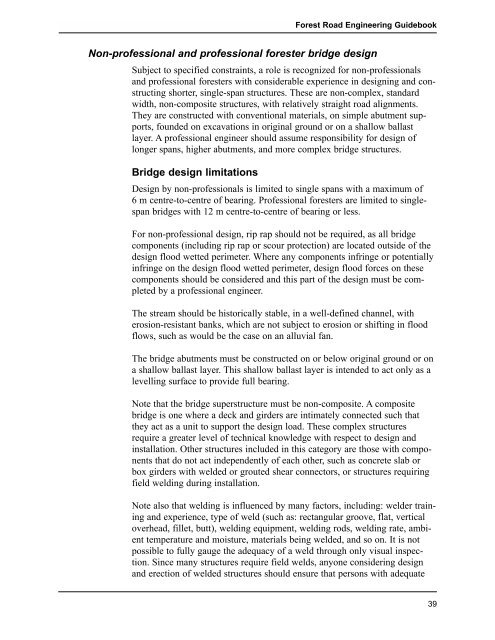Forest Road Engineering Guidebook - Ministry of Forests
Forest Road Engineering Guidebook - Ministry of Forests
Forest Road Engineering Guidebook - Ministry of Forests
You also want an ePaper? Increase the reach of your titles
YUMPU automatically turns print PDFs into web optimized ePapers that Google loves.
Non-pr<strong>of</strong>essional and pr<strong>of</strong>essional forester bridge design<br />
Subject to specified constraints, a role is recognized for non-pr<strong>of</strong>essionals<br />
and pr<strong>of</strong>essional foresters with considerable experience in designing and constructing<br />
shorter, single-span structures. These are non-complex, standard<br />
width, non-composite structures, with relatively straight road alignments.<br />
They are constructed with conventional materials, on simple abutment supports,<br />
founded on excavations in original ground or on a shallow ballast<br />
layer. A pr<strong>of</strong>essional engineer should assume responsibility for design <strong>of</strong><br />
longer spans, higher abutments, and more complex bridge structures.<br />
Bridge design limitations<br />
<strong>Forest</strong> <strong>Road</strong> <strong>Engineering</strong> <strong>Guidebook</strong><br />
Design by non-pr<strong>of</strong>essionals is limited to single spans with a maximum <strong>of</strong><br />
6 m centre-to-centre <strong>of</strong> bearing. Pr<strong>of</strong>essional foresters are limited to singlespan<br />
bridges with 12 m centre-to-centre <strong>of</strong> bearing or less.<br />
For non-pr<strong>of</strong>essional design, rip rap should not be required, as all bridge<br />
components (including rip rap or scour protection) are located outside <strong>of</strong> the<br />
design flood wetted perimeter. Where any components infringe or potentially<br />
infringe on the design flood wetted perimeter, design flood forces on these<br />
components should be considered and this part <strong>of</strong> the design must be completed<br />
by a pr<strong>of</strong>essional engineer.<br />
The stream should be historically stable, in a well-defined channel, with<br />
erosion-resistant banks, which are not subject to erosion or shifting in flood<br />
flows, such as would be the case on an alluvial fan.<br />
The bridge abutments must be constructed on or below original ground or on<br />
a shallow ballast layer. This shallow ballast layer is intended to act only as a<br />
levelling surface to provide full bearing.<br />
Note that the bridge superstructure must be non-composite. A composite<br />
bridge is one where a deck and girders are intimately connected such that<br />
they act as a unit to support the design load. These complex structures<br />
require a greater level <strong>of</strong> technical knowledge with respect to design and<br />
installation. Other structures included in this category are those with components<br />
that do not act independently <strong>of</strong> each other, such as concrete slab or<br />
box girders with welded or grouted shear connectors, or structures requiring<br />
field welding during installation.<br />
Note also that welding is influenced by many factors, including: welder training<br />
and experience, type <strong>of</strong> weld (such as: rectangular groove, flat, vertical<br />
overhead, fillet, butt), welding equipment, welding rods, welding rate, ambient<br />
temperature and moisture, materials being welded, and so on. It is not<br />
possible to fully gauge the adequacy <strong>of</strong> a weld through only visual inspection.<br />
Since many structures require field welds, anyone considering design<br />
and erection <strong>of</strong> welded structures should ensure that persons with adequate<br />
39

















